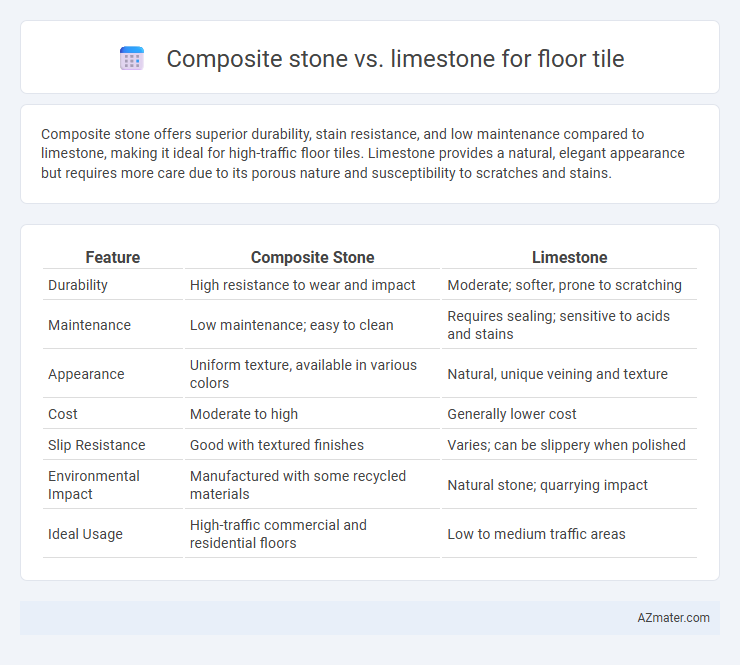Composite stone offers superior durability, stain resistance, and low maintenance compared to limestone, making it ideal for high-traffic floor tiles. Limestone provides a natural, elegant appearance but requires more care due to its porous nature and susceptibility to scratches and stains.
Table of Comparison
| Feature | Composite Stone | Limestone |
|---|---|---|
| Durability | High resistance to wear and impact | Moderate; softer, prone to scratching |
| Maintenance | Low maintenance; easy to clean | Requires sealing; sensitive to acids and stains |
| Appearance | Uniform texture, available in various colors | Natural, unique veining and texture |
| Cost | Moderate to high | Generally lower cost |
| Slip Resistance | Good with textured finishes | Varies; can be slippery when polished |
| Environmental Impact | Manufactured with some recycled materials | Natural stone; quarrying impact |
| Ideal Usage | High-traffic commercial and residential floors | Low to medium traffic areas |
Overview: Composite Stone and Limestone Floor Tiles
Composite stone floor tiles combine natural stone fragments with resins and pigments, offering enhanced durability, stain resistance, and a wide range of design options ideal for high-traffic areas. Limestone floor tiles, composed mainly of sedimentary calcium carbonate, provide a classic, warm aesthetic with natural variations but require regular sealing to prevent moisture damage and staining. Both materials contribute distinct textures and appearances, with composite stone excelling in low maintenance and versatility, while limestone offers timeless elegance and natural beauty.
Material Composition and Manufacturing Process
Composite stone floor tiles are engineered materials made from a blend of natural stone aggregates, resins, and pigments, creating a dense, durable surface with consistent quality. Limestone floor tiles consist primarily of calcium carbonate extracted from sedimentary rock, shaped and finished through cutting, polishing, or honing for aesthetic appeal. The manufacturing of composite stone involves molding and curing under controlled conditions, while limestone tiles undergo natural quarrying followed by minimal processing to preserve the stone's organic texture.
Appearance and Aesthetic Options
Composite stone floor tiles offer a wide range of customizable colors and patterns, mimicking natural materials while allowing more uniformity and modern design versatility. Limestone provides a classic, timeless aesthetic with natural variations, soft earthy tones, and subtle textures that enhance rustic or traditional interiors. Both materials deliver distinct visual appeal, with composite stone excelling in consistency, and limestone prized for its organic, natural character.
Durability and Wear Resistance
Composite stone offers superior durability and wear resistance compared to limestone, making it ideal for high-traffic areas and commercial spaces. While limestone is softer and more prone to scratches, chips, and acid etching, composite stone consists of natural stone fragments and resins that enhance its hardness and longevity. This makes composite stone floor tiles resistant to impact, stains, and heavy footfall, extending their lifespan significantly beyond that of traditional limestone tiles.
Maintenance and Cleaning Requirements
Composite stone tiles require minimal maintenance due to their non-porous surface, resisting stains and moisture effectively, making cleaning simple with just mild detergent and water. Limestone, being a porous natural stone, demands regular sealing to prevent staining and etching, and cleaning should be done with pH-neutral cleaners to avoid surface damage. Composite stone offers a more durable and low-maintenance flooring solution compared to limestone, which requires careful upkeep to maintain its appearance.
Cost Comparison: Initial and Long-Term Expenses
Composite stone floor tiles generally have a higher initial cost compared to limestone, due to advanced manufacturing processes and greater durability. Limestone offers a more affordable upfront price but may incur higher long-term expenses from maintenance, sealing, and potential repairs triggered by its natural porosity. Evaluating total cost of ownership favors composite stone in high-traffic areas where longevity and lower maintenance reduce lifecycle expenses.
Installation Methods and Considerations
Composite stone floor tiles offer easier installation due to their uniform size and thickness, often accommodating tile adhesive and standard grout lines without surface preparation. Limestone tiles require careful subfloor leveling and sealing before installation to prevent moisture absorption and staining, with natural variations demanding precise cutting and fitting to maintain aesthetic consistency. Both materials benefit from professional installation to ensure durability, but composite stone suits DIY projects better due to simpler handling and reduced weight.
Environmental Impact and Sustainability
Composite stone floor tiles often incorporate recycled materials and require less energy in manufacturing, making them a more sustainable option compared to natural limestone. Limestone extraction involves quarrying, which leads to habitat disruption and higher carbon emissions due to heavy machinery and transportation. Choosing composite stone can reduce environmental impact, promote resource efficiency, and support sustainable building practices.
Best Applications: Residential and Commercial Uses
Composite stone offers superior durability and stain resistance, making it ideal for high-traffic commercial spaces such as offices, retail stores, and hotels. Limestone provides a natural, elegant appearance suited for residential settings like living rooms and bathrooms, where moderate foot traffic and a warmer aesthetic are preferred. Both materials perform well in their respective uses, with composite stone excelling in heavy-duty environments and limestone enhancing residential interiors with its classic beauty.
Pros and Cons: Composite Stone vs. Limestone Tiles
Composite stone floor tiles offer high durability, resistance to stains, and low maintenance compared to limestone tiles, making them ideal for high-traffic areas. Limestone tiles provide a natural, elegant appearance with unique textures but are more porous, prone to scratching, and require regular sealing to prevent damage. While composite stone excels in longevity and ease of care, limestone offers aesthetic warmth at the cost of higher upkeep and vulnerability to wear.

Infographic: Composite stone vs Limestone for Floor Tile
 azmater.com
azmater.com